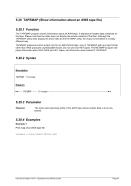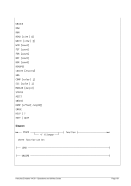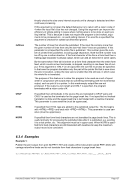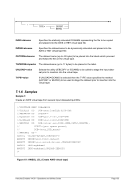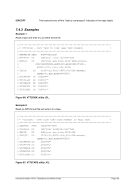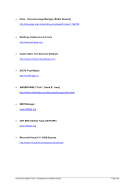6.2.8 Job Separator Control File
The “Job Separator Control File” describes the layout of the guest’s job separator page as well as other
spooler options. HercPrt uses this control file to be able to decide when the end of the spooled report has
been reached as well as how to name the resulting file.
Additionally the control file also contains various options related to how you want your spooled output to
look like for those file types whose appearance can be customized (currently limited to Portable
Document Files (PDF) and to a limited degree to Rich Text Format (RTF) files).
HercPrt provides sample control files already configured for three of the most popular Hercules guest
operating systems:
Control File Name
Operating System
DOSVSR23.INI
DOS/VS Release 34
VM370R6.INI
VM/370 Release 6
MVSJES2.INI
MVS V3.8J
Table 6: Sample Control Files
The provided samples can either be used as is or can be customized to suit your needs.
6.2.8.1 [Separator] section
The [Separator] section contains the information which defines what your guest's end-of-job or beginning-
of-job separator page looks like. Each "trigger" defines one line of the separator page, and all of them
must match together as a group in order for the page to be considered a job separator page.
For most systems these lines would be those which appear on your guest's end-of-job separator page,
not the beginning-of-job separator page, since it is the end-of-job separator page which defines where the
current print job ends and thus where the next one begins.
Some operating systems however use a spooler which only outputs beginning-of-job separator pages,
making it impossible to know with any degree of certainty when the current print job has ended (except in
the special case where another print job immediately follows it; the next print job's beginning-of-job sepa-
rator would thus also serve to define the end of the previous job). Nevertheless a special format is
supported to try and accommodate these unusual spoolers.
6.2.8.1.1 Pages=
The first 'n' value of the "Pages=(n,m)" string specifies the number of consecutively identical end-of-job
separator pages there are and defines the number of consecutive times in a row that all triggers must
match.
The 'm' value defines the number of additional end-of-job separator pages there are following the identical
pages. This parameter is needed to accommodate spoolers such as DOS/VS's POWER/VS spooler those
separator pages are not all the same.
For MVS's JES2 spooler (whose separator pages are all the same) you should specify "(2,0)", whereas
for DOS/VS's POWER/VS spooler (whose separator pages are not) the value "(2,1)" should be used
instead. Both values of course presume the usual two page default. If your guest uses only one separator
page then you should of course use (1,0) or (1,1) instead.




























































































